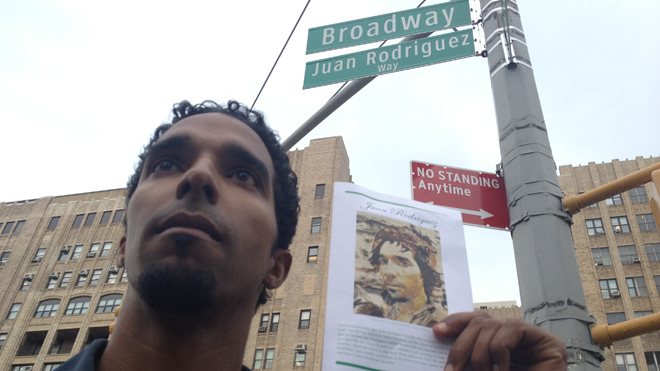The first immigrant to New York City has been identified by scholars at City University — and politicians at City Hall have already named a swath of upper Broadway in his honor.
Sailor-turned-merchant Juan Rodriguez arrived downtown in 1613 from his home on the island now known as the Dominican Republic, making him the first visitor to spend a night in Manhattan, researchers say.
He also became the first non-Indian to settle permanently in the city, the first Dominican resident, the first Latino and the first settler with African blood, according to the City University of New York's Dominican Studies Institute.
"He was a very early predecessor of the large Dominican population that thrives in the city today," said Institute Director Ramona Hernandez. "And his story belongs to the history of all New Yorkers."
His name will soon be plastered in a mostly Dominican area along Broadway — from W. 159th St. in Washington Heights to W. 218th St. in Inwood — after Mayor Bloomberg on Tuesday signed a bill renaming the 59-block stretch "Juan Rodriguez Way."
"The whole city — a city of hard-working immigrants, just like Juan — should know his story," said Dominican-born City Councilman Ydanis Rodriguez, who represents the area and sponsored the bill.
00:0602:46

"And it will: We're already planning a big celebration for May, 2013, to mark the 400th anniversary of his arrival in New York."
On Friday at 6 p.m., a panel of scholars will share their findings at a two-hour conference, hosted by the Institute, at City College, 160 Convent Ave. at 138th St. The event is free and open to the public.
It was 1613 when Santo Domingo native Rodriguez boarded the Dutch trading ship Jonge Tobias in the Caribbean and sailed into what is now New York Harbor.
Apparently, he liked what he saw on the virgin island of Manhattan because when the ship returned to its home port in Holland, Rodriguez stayed behind, equipped with 80 axes and hatchets to trade with the Indians.
Although explorer Henry Hudson had passed through on the Half Moon in 1609, heading north, up the river that now bears his name, Rodriguez was the first non-native to make the island his home, researchers found.
European residents didn't arrive until 1614. That year, two other Dutch trading vessels returned, and a commercial row erupted between rival sea captains over the price Rodriguez was charging for his beaver pelts and who would profit from them and ship them home to Holland.
The dispute proved a blessing for historians: Ship logs, affidavits filed by angry captains and other archival records, discovered in Amsterdam and translated from the Dutch, provided the details of the Rodriguez saga.
His landfall in 1613 predates by 12 years the official founding of New Amsterdam by Dutch colonists, and by 13 years the purchase of Manhattan from the Indians by Peter Minuit.
The first Jewish settlers arrived from Brazil in 1654, and the British wrested control of the colony from the Dutch without bloodshed in 1664, renaming it New York.



